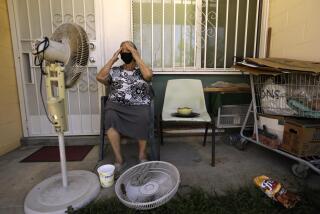Home Improvement : CUT YOUR UTILITY BILLS : Do-It-Yourself Window Film Blocks Heat, Fading
- Share via
QUESTION: I want to apply permanent-type window film myself to block the sun’s heat and stop the fading of my curtains. Are there any new do-it-yourself films that are fairly clear and help cut winter heat loss too?
ANSWER: The heat coming through your windows from both the sun’s direct rays and reflected heat can greatly increase your air-conditioning costs. The problem of fading curtains and furniture near windows occurs year-round.
There are several basic types of permanent window film to select from depending on your specific needs. Some of the new year-round energy-saving films have a very slight tint and low reflectivity.
When looking out you won’t even notice the film is on your windows. All types of window film block nearly all the fading ultraviolet rays. With window film applied, the glass will not shatter and splinter when it is broken. This is a real safety advantage for children and during stormy weather.
The newer year-round energy-saving window films use a special low-E (low emissivity) coating. This is a microscopically thin layer of metal atoms sandwiched between the several layers of the film. This is the same type of coating used on new super-energy-efficient replacement window glass.
Although visible light readily passes through low-E window film, the film is reflective to the longer-wave-length heat rays. For example, in the winter, heat from your body bounces back indoors when you stand by a film-covered window. You feel much warmer and your heating bills are lower.
In the summer, low-E film blocks much of the sun’s direct heat from getting indoors through your windows. It is also extremely effective for blocking longer-wave-length heat that is reflected from sidewalks, patios, etc.
For strictly lowering air-conditioning costs in the summer, a more-reflective standard type of window film is very effective. Although this gives a more-reflective look from outdoors, it blocks a significant amount of the sun’s heat. It is commonly used in hot southern climates.
Window film is very easy to install yourself. Generally, there is a water-activated adhesive on one side. You just remove the protective backing, mist the window and the film with water, and squeegee it onto the window. After it is on your window, cut off the excess with a razor blade.
With reasonable care, the window film should last for many years. You can clean it with soapy water as you would any uncoated window.
You can write to me at the address below for Utility Bills Update No. 289 showing a list of names, addresses and telephone numbers of window film manufacturers, two small sample pieces of the new low-E and the more-reflective films to try on your windows, and specifications on several of the films. Please include $1 and a self-addressed stamped business-size envelope.
Turn Water Heater Down in Summer
Q: I am trying to keep our water heating costs as low as possible. Does it make sense to lower the hot water temperature at the water heater in the summer since the incoming water is warmer?
A: Lowering the hot water temperature lowers your water heating costs. Also, a hotter water temperature causes more heat loss from the water heater tank. This increases the load on your air conditioner.
The greatest need for hot water is often when the family showers in the morning. Since most people take cooler showers in the summer, you don’t need the water as hot to get the desired shower temperature. Also, the incoming water is warmer, so less hot water needs to be mixed in.
Window Film Blocks Easy-to-apply window film blocks sun that can fade curtains and run up air-conditioning costs. Letters and questions to Dulley, a Cincinnati-based engineering consultant, may be sent to James Dulley, Los Angeles Times, 6906 Royalgreen Drive, Cincinnati, Ohio 45244.
More to Read
Inside the business of entertainment
The Wide Shot brings you news, analysis and insights on everything from streaming wars to production — and what it all means for the future.
You may occasionally receive promotional content from the Los Angeles Times.










